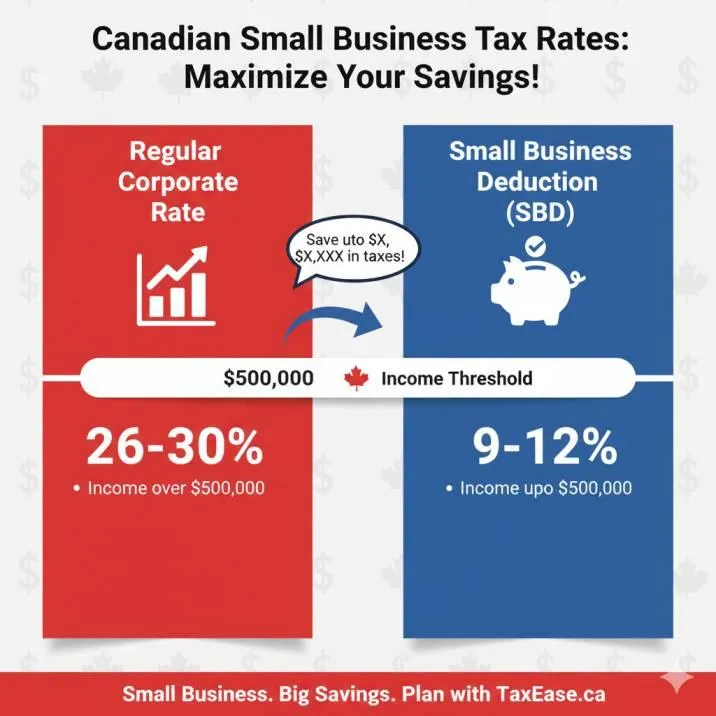
Tax Planning Tips for Canadian Small Business Owners
Why Small Business Tax Planning Matters
Running a small business in Canada means more than managing customers and operations—it also means managing your tax bill strategically. Without proper tax planning, you could be leaving thousands of dollars on the table each year.
Whether you’re a sole proprietor, freelancer, or incorporated Canadian-controlled private corporation (CCPC), understanding how to maximize small business tax savings is critical for long-term success.
👉 At Taxease, we help Canadian entrepreneurs minimize taxes legally while staying compliant with CRA rules.
Understanding the Small Business Deduction (SBD) in Canada
The Small Business Deduction (SBD) is the single most powerful tax break for Canadian small businesses.
How the SBD Works
Applies to Canadian-Controlled Private Corporations (CCPCs)
Reduces the federal corporate tax rate on the first $500,000 of active business income
Combined federal and provincial rates can be as low as 9–12% (varies by province)
💡 Pro Tip: If your company earns passive investment income above $50,000 annually, the SBD limit starts to shrink. Planning with a holding company or tax-efficient investing strategy can protect access.

Choosing the Right Business Structure for Tax Efficiency
Your legal structure directly impacts your taxes.
Sole Proprietorship
Simple and cheap to set up
Business income reported on your personal T1 return
Limited tax planning flexibility
Incorporation
Access to Small Business Deduction
Ability to split income with family (if reasonable)
More complex compliance but major tax-deferral opportunities
🔗 See CRA’s guide on Incorporating Your Business.

Salary vs Dividend – Which Should You Pay Yourself?
One of the most debated topics in Canadian small business tax planning is salary vs dividends.
Salary
Deductible business expense → lowers corporate taxable income
Builds RRSP contribution room
Contributes to CPP (retirement benefits)
Dividends
Paid from after-tax corporate income
Lower personal tax rate than salary in some provinces
Does not create RRSP room or CPP credits
💡 Best Strategy: Many business owners use a mix of salary and dividends to balance tax efficiency and retirement planning.

Essential Small Business Tax Deductions in Canada
The CRA allows several business expense write-offs that can significantly reduce taxable income.
Common Small Business Tax Deductions
Home office expenses (utilities, rent, internet)
Vehicle expenses (mileage, insurance, repairs)
Business meals & entertainment (50% deductible)
Capital Cost Allowance (CCA) on equipment & assets
Professional fees (legal, accounting, consulting)
🔗 Full CRA guide: Business Expenses You Can Claim.

Advanced Tax Planning Strategies for Small Business Owners
Beyond deductions, there are strategic tax moves that can save you even more.
1. Income Splitting with Family
Pay reasonable salaries to a spouse or children working in the business
Shifts income from higher tax brackets to lower ones
2. Tax Deferral
Keep profits in the corporation taxed at the low SBD rate
Defer personal taxes until funds are withdrawn
3. SR&ED Tax Credit (Scientific Research & Experimental Development)
Up to 35% refundable credit for qualifying R&D expenses
Highly valuable for tech startups and product development companies
4. Using a Holding Company
Protects retained earnings from creditors
Helps manage passive income rules that reduce SBD eligibility

Common Tax Mistakes Small Business Owners Should Avoid
Even experienced entrepreneurs slip up. Here are costly mistakes to avoid:
Not keeping receipts or detailed records
Mixing personal and business expenses
Missing the corporate filing deadline (T2 return)
Overlooking GST/HST obligations
Ignoring tax implications of passive income inside a CCPC

Year-End Tax Planning Moves
Smart tax planning doesn’t happen in April—it happens before year-end. Consider:
Accelerating expenses into the current year (equipment, supplies)
Deferring income to the next year (if in a high-tax bracket now)
Making final RRSP contributions to reduce personal tax
Reviewing salary vs dividend mix before December 31
💡 Tip: Book a consultation with Taxease before year-end to create a personalized tax-saving strategy.
How Taxease Helps Canadian Small Business Owners
At Taxease, we go beyond basic filing. Our experts provide:
Customized tax strategies for small business owners
Guidance on deductions, SBD, salary vs dividends
Support with CRA compliance and avoiding penalties
Year-round planning to ensure maximized after-tax profit

Tax Planning is Profit Planning
Tax planning is not just about avoiding penalties—it’s about building long-term financial health. By leveraging deductions, structuring income smartly, and making proactive moves, Canadian entrepreneurs can keep more profit in their pockets.
👉 Don’t navigate small business taxes alone. Partner with Taxease for expert guidance and maximize your savings this year.
Ready to reduce your corporate tax bill and unlock smarter strategies?
Contact Taxease today and start planning for a more profitable tomorrow.